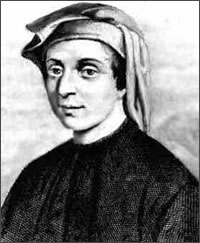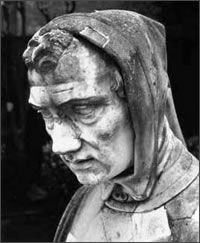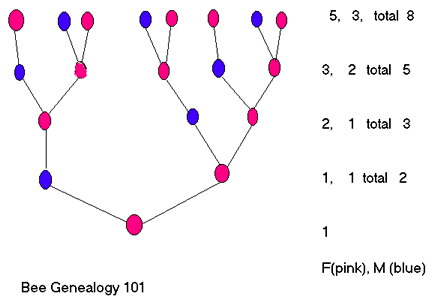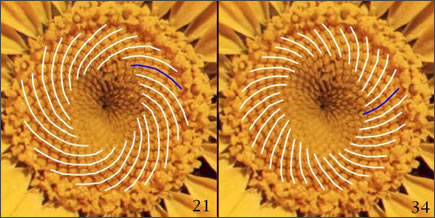Factors
of Fibonacci
Another interesting characteristic of the Fibonacci sequence
is that no two consecutive Fibonacci numbers have any common factors. Like this:
Fibonacci
number and Prime Factors |
| Fibonacci
Number | Prime Factors | Fibonacci
Number | Prime Factors |
| 1 | 1 | 55 | 5x11 |
| 1 | 1 | 89 | 89 |
| 2 | 2 | 144* | 2x2x2x2x3x3* |
| 3 | 3 | 233 | 233 |
| 5 | 5 | 377 | 13x29 |
| 3 | 2x2x2 | 610 | 2x5x61 |
| 13 | 13 | 987 | 3x7x47 |
| 21 | 3x7 | 1597 | 1597 |
| 34 | 2x17 | 2584 | 2x2x2x17x19 |
*
The 12th Fibonacci number (144) is the square of 12.
It is also the only square
number in the entire sequence
well, as long as you don't count the number
1.
4.
Fibonacci goes Gold
The Golden Ratio
1.618033988749894842...
The Golden Ratio is a "special" number that goes on forever, like Pi,
without ever repeating. It is often symbolized as the greek letter Phi.
The
Golden Rectangle
The golden Rectangle is believed to be the most aesthetically
pleasing proportion. It is a rectangle in which the length to width ratio is the
golden ratio. If the Length of the rectangle is equal to Width x1.62 (or Phi-the
Golden Ratio) then it is a golden rectangle. Should I try that agian another way?
Trudi Hammel Garland, in Fascinating Fibonaccis explains it this way:
If
the small part is called S and the large part is called L, the proportions can
be mathematically stated as follows:
S/L
= L/S+L
That is about as far as my mathematics descriptions will take me, but
if you need more, or a precise visual, then here's the place to go for some "Golden
Geometry"
Fibonacci Squares
A
Fibonacci square will work a bit differently, but with a similar result. If you
begin with a square that is one by one (unit, cenitmeter, inch...no matter) and
add another that is the same size you create a rectangle. If you continue adding
squares whose sides are the length of the rectangle - that longer side will always
be a Fibonacci number. If you keep adding squares, you will end up with a rectangle
that gets closer and closer to the "Golden Rectangle".
This
is my aproximation that bares only a symbolic, but nowhere near technically correct,
representation of the above described process.

Golden
Triangles
In Fascinating Fibonaccis by Trudi Hammel Garland, Golden Triangles
are explained thusly:
It is an isosceleles triangle with one short side in
golden proportion to each of the two longer, equal sides. Fibonacci numbers can
be used to construct such triangles... Among the interesting properties of the
golden triangle is the fact that the bisector of a base angle (which is always
72o) cuts the side opposite it into the golden proportions. That bisector also
cuts the triangle into two new isosceles triangles...whose areas are in golden
proportion to each other. The process can be repeated endlessly.
Again,
I have done my best to demonstrate this process, it is not a prefect representation:
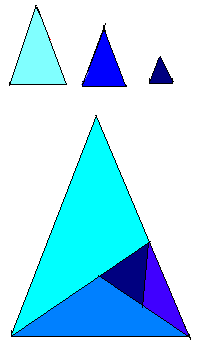
Aesthetically
Pleasing Fibonacci?
5.
Architecture
Is there something about the Fibonacci sequence that
appeals to people, that makes it pleasing to us, even if we are unaware of it's
existence? Everything I have read so far indicates that there is. And there is
quite a bit of evidence. The golden rectangle seems to appear throughout history
in architecture. From the Parthenon, the United Nations Building and even the
burial chamber of Ramses IV, the golden rectangle and ratio are there.
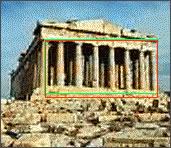
6.
Art
It would be difficult for most people to articulate exactly
what it is that they find pleasing in art and other things of beauty. Proportion
would be an easy place to begin when attempting that description. This was especially
true of the Greek whose art including urns, vases, statues and building frequently
reveals the golden ratio and rectangle. There are numerous examples of art in
many different forms and cultures where the golden ratio or golden rectangle appears.
In less than scientific term, it is a work where the focal point appears to fit
of fill the shape and proportions of the golden rectangle.
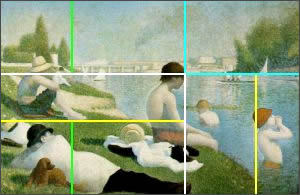
7.
Music at the Fibonacci series
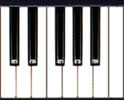 | The
Fibonacci series appears in the foundation of aspects of art, beauty and life.
Even music has a foundation in the series, as:
13
notes separate each octave of
8 notes in a scale,
of which the
5th and 3rd
notes create the basic foundation of all chords, and are based on whole tone which
is
2 steps from the root tone, that is the
1st
note of the scale. |
Note
too how the piano keyboard scale of 13 keys has 8
white keys and 5 black keys, split into groups of
3 and 2.
8.
The Formulas
The Golden Ratio

.Where Phi has the value 1.618..
Fibonacci
Sequence
But you have to know the previous number!
F(1) = 1
F
(2)= 1
F (n) = F (n-1) + F (n-2) for n >
2
1 | 1 | 2 | 3 | 5 | 8 | 13 | 21 | 34 | 55 |
. | . | 1+1=2 | 1+2=3 | 2+3=5 | 3+5=8 | 5+8=13 | 8+13=21 | 13+21=34 | 21+34=55 |
1 | 1 | 2 | 3 | 5 | 8 | 13 | 21 | 34 | 55 |
1/1=1 | 1/2=.5 | 2/3=.667 | 3/5=.6 | 5/8=.625 | 8/13=.615 | 13/21=.619 | 21/34=.617 | 34/55=
.618 | 55/89=
.618 |
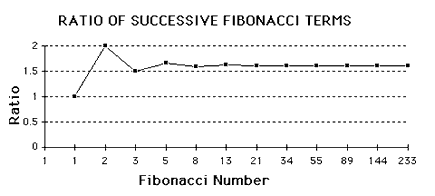
And
for those not faint of heart

.Where a and b are the roots of the quadratic equation

Calculating
the Golden Ratio/Fibonnacci Sequence
9.
History of Phi
.While
the proportion known as the Golden Mean has always existed in mathematics and
in the physical universe, it is unknown exactly when it was first discovered and
applied by mankind. It is reasonable to assume that it has perhaps been discovered
and rediscovered throughout history, which explains why it goes under several
names.
Uses in architecture date to the
ancient Egyptians and Greeks
The Egytians used
both pi and phi in the design of the Great Pyramids. The Greeks, who called it
the Golden Section, based the entire design of the Parthenon on this proportion.
Phidias
(500 BC - 432 BC), a Greek sculptor and mathematician, studied phi and applied
it to the design of sculptures for the Parthenon.
Plato
(circa 428 BC - 347 BC), in his views on natural science and cosmology presented
in his "Timaeus," considered the golden section to be the most binding
of all mathematical relationships and the key to the physics of the cosmos.
Euclid
(365 BC - 300 BC), in "Elements," referred to dividing a line at the
0.6180399... point as dividing a line in the extreme and mean ratio. This later
gave rise to the use of the term mean in the golden mean. He also linked this
number to the construction of a pentagram.
The
Fibonacci Series was discovered around 1200 AD
Leonardo Fibonacci, an
Italian born in 1175 AD (2) discovered the unusual properties of the numerical
series that now bears his name, but it's not certain that he even realized its
connection to phi and the Golden Mean. His most notable contribution to mathematics
was a work known as Liber Abaci, which became a pivotal influence in adoption
by the Europeans of the Arabic decimal system of counting over Roman numerals.
(3)
It was first called the "Divine
Proportion" in the 1500's
Da Vinci provided illustrations for a dissertation
published by Luca Pacioli in 1509 entitled "De Divina Proportione" (1),
perhaps the earliest reference in literature to another of its names, the "Divine
Proportion." This book contains drawings made by Leonardo da Vinci of the
five Platonic solids. It was probably da Vinci who first called it the "sectio
aurea," which is Latin for golden section.
The
Renaissance artists used the Golden Mean extensively in their paintings and sculptures
to achieve balance and beauty. Leonardo Da Vinci, for instance, used it to define
all the fundamental proportions of his painting of "The Last Supper,"
from the dimensions of the table at which Christ and the disciples sat to the
proportions of the walls and windows in the background.
Johannes
Kepler (1571-1630), discoverer of the elliptical nature of the orbits of the planets
around the sun, also made mention of the "Divine Proportion," saying
this about it:
"Geometry has two great treasures: one is the theorem of
Pythagoras; the other, the division of a line into extreme and mean ratio. The
first we may compare to a measure of gold; the second we may name a precious jewel."
The
term "Phi" was not used until the 1900's
It wasn't until the
1900's that American mathematician Mark Barr used the Greek letter phi to designate
this proportion. By this time this ubiquitous proportion was known as the golden
mean, golden section and golden ratio as well as the Divine proportion. Phi is
the first letter of Phidias (1), who used the golden ratio in his sculptures,
as well as the Greek equivalent to the letter "F," the first letter
of Fibonacci. The character for phi, however, also has some interesting theological
implications.
Recent appearances of Phi in
math and physics
Phi continues to open new doors in our understanding of
life and the universe. It appeared in Roger Penrose's discovery in the 1970's
of "Penrose Tiles," which first allowed surfaces to be tiled in five-fold
symmetry. It appeared again in the 1980's in quasi-crystals, a newly discovered
form of matter.
Phi as a door to understanding
life
The description of this proportion as Golden and Divine is fitting
perhaps because it is seen by many to open the door to a deeper understanding
of beauty and spirituality in life. That's an incredible role for a single number
to play, but then again this one number has played an incredible role in human
history and in the universe at large.
10.
Theology
Is there meaning hidden in  ,
the symbol for the Golden Number?
,
the symbol for the Golden Number?
The use of the Greek letter Phi  to represent the golden number 1.618... is generally said to acknowledge Phidias,
a 5th century B.C. sculptor and mathematician of ancient Greece, who studied phi
and created sculptures for the Parthenon and Olympus.
to represent the golden number 1.618... is generally said to acknowledge Phidias,
a 5th century B.C. sculptor and mathematician of ancient Greece, who studied phi
and created sculptures for the Parthenon and Olympus.
The
message from scripture of all the major monotheistic religions is that God is
One, Who created the universe from nothing, splitting nothingness into offsetting
forces and elements. Today we understand the universe to consist of positive and
negative atomic and subatomic particles and charges, matter and anti-matter, all
coming from a singularity in what we term the "Big Bang."
Curiously,
the mathematical constant of 1.618... that is found throughout creation is represented
by the symbol F, which is the symbol 0 for nothing split in two by the symbol
1 for unity and one. Could this be the true meaning behind the symbol  ?
?
| | |
Nothing | Unity
/ God | Nothing
split
by
Unity
is Phi,
the constant
of creation |
Adding
Unity to nothingness produces the Fibonacci series, which converges on 
Now
ADD God to the void, or Unity to Nothing. In other words, add 0 plus 1 to get
1, and then follow this pattern to the Infinite. This is the Fibonacci series.
The ratio of each number in the series to the one before it converges on  as you move towards infinity,
as you move towards infinity,  !
!
Number
in the series | 0 | 1 | 1 | 2 | 3 | 5 | 8 | 13 | ... | |
Ratio
of
each number in the series
to the
previous number in the series | . | | 1 | 2 | 1.5 | 1.66... | 1.6000 | 1.625 | ... | |
The
Golden Proportion is analogous to God's relationship to creation
The Golden
Section, or Phi, found throughout nature, also applies in understanding the relationship
of God to Creation. In the golden section, we see that there is only one way to
divide a line so that its parts are in proportion to, or in the image of, the
whole:
The ratio of the larger section (B) to
the whole line (A) is the same as the ratio as the
smaller section (C)
to the large section (B):

Only
"tri-viding" the whole preserves the relationship to the whole
And
so it is with our understanding of God, that we are created in His image. Not
by dividing the whole, but only by tri-viding the whole does each piece retain
its unique relationship to the whole. Only here do we see three that are two that
are one.
The Golden Section
as a universal constant of design
The teachings of most religions express
the thought that part of God is within each of us and that we are created in His
image. The pervasive appearance of phi throughout life and the universe is believed
by some to be the signature of God, a universal constant of design used to assure
the beauty and unity of His creation.
11.
Phi and the Solar System
Certain solar system
orbital periods are related to ph
| Certain
planets of our solar system seem to exhibit a relationship to phi, as shown by
the following table of the time it takes to orbit around the Sun: |  |
| . | Mercury | Venus | Earth | Jupiter | Saturn |
|
Powerof Phi | -3 | -1 | 0 | 5 | 7 |
|
Decimal Result | 0.24 | 0.62 | 1.0 | 11.1 | 29.0 |
|
Actual Period | 0.24 | 0.62 | 1.0 | 11.9 | 29.5 |
Saturn's
rings are divided at two phi points
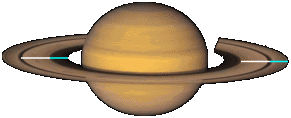 | The
Cassini division in the rings of Saturn falls at the Golden Section of the width
of the ring. |
A closer
look at Saturn's rings reveals a darker inner ring which exhibits the same golden
section proportion as the brighter outer ring.

Venus
and Earth reveal a phi relationship
Venus and the Earth are linked in an
unusual relationship involving phi. Start by letting Mercury represent the basic
unit of orbital distance and period in the solar system:
| Planet | Distance
from the sun in km (000) | Distance
where Mercury equals 1 | Period
where Mercury equals 1 |
| Mercury | 57,910 | 1.0000 | 1.0000 |
| Venus | 108,200 | 1.8684 | 2.5490 |
| Earth | 149,600 | 2.5833 | 4.1521 |
Curiously enough we find:
Period of Venus * Phi = Distance of the Earth

In
addition, Venus orbits the Sun in 224.695 days while Earth orbits the Sun in 365.242
days, creating a ratio of 8/13 (both Fibonacci numbers) or 0.615 (roughly phi.)
Thus 5 conjunctions of Earth and Venus occur every 8 orbits of the Earth around
the Sun and every 13 orbits of Venus.
Mercury,
on the other hand, orbits the Sun in 87.968 Earth days, creating a conjunction
with the Earth every 115.88 days. Thus there are 365.24/115.88 conjunctions in
a year, or 22 conjunctions in 7 years, which is very close to Pi!
Relative
planetary distances average to Phi
The average of the mean orbital distances
of each successive planet in relation to the one before it approximates phi:
| Planet | Mean
distance in million kilometers per NASA | Relative
mean distance where Mercury=1 |
| Mercury | 57.91 | 1.00000 |
| Venus | 108.21 | 1.86859 |
| Earth | 149.60 | 1.38250 |
| Mars | 227.92 | 1.52353 |
| Ceres | 413.79 | 1.81552 |
| Jupiter | 778.57 | 1.88154 |
| Saturn | 1,433.53 | 1.84123 |
| Uranus | 2,872.46 | 2.00377 |
| Neptune | 4,495.06 | 1.56488 |
| Pluto | 5,869.66 | 1.30580 |
| Total | . | 16.18736 |
| Average | . | 1.61874 |
| Phi | . | 1.61803 |
| Degree
of variance | (0.00043) |
12.
"89" and the Fibonacci Series
The
reciprocal of 89, a Fibonacci number, is based on the Fibonacci series
This
is a little curiousity involving the number 89, one of the Fibonacci series numbers.
If
you take each Fibonacci number, divide it by 10 raised to the power of its position
in the Fibonacci sequence and add them all together, you get 0.011235955..., the
same number as the reciprocal of 89.
Note: You
can see the beginning of the Fibonacci sequence in the first 6 digits of the decimal
equivalent of 1/89. (i.e., 0,1,1,2,3,5 appears as 0.011235..)
Note
the Fibonacci series in green Note
the sequence number of the Fibonacci series in red | 1/89= 0
/ (10 ^ 1 ) +
1 / (10 ^ 2 ) +
1 / (10 ^ 3 ) +
2 / (10 ^ 4 ) +
3 / (10 ^ 5 ) +
5 / (10 ^ 6 ) +
8 / (10 ^ 7 ) +
13 / (10 ^ 8 ) + | 0.011235955= 0.0
+
0.01 +
0.001 +
0.0002 +
0.00003 +
0.000005 +
0.0000008 +
0.00000013
+ |
13.
Fibonacci numbers define the movements of stocks in Elliott Wave Theory
Fibonacci
numbers were used by W.D Gann and R.N. Elliott, pioneers in technical analysis
of the stock market. In Elliott Wave Theory, all major market moves are described
by a five-wave series. The classic Elliott Wave series consists of an initial
wave up, a second wave down (often retracing 61.8% of the initial move up), then
the third wave (usually the largest) up again, then another retracement, and finally
the fifth wave, which would exhaust the movement. In addition, each of the major
waves (1, 3, and 5) could themselves be separated into subwaves, and so on, and
exhibit other Fibonacci relationships.
A sample
stock price wave analysis could look something like this:
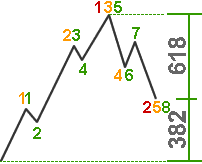
Major,
minor and sub
waves are shown in RED,
YELLOW and
GREEN and the total number of increases and decreases
(2, 5 or
8) is a Fibonacci number. Note
too that the predicted end result is based in the Fibonacci series as well as
the end price is 61.8% of the high and 0.618 is equal 1/  and 0.382 is 1/
and 0.382 is 1/  2.
2.
14. What is Phi?
Phi
( = 1.618033988749895...
) is simply an irrational number like pi ( = 3.14159265358979... ), but one with
many unusual mathematical properties.
= 1.618033988749895...
) is simply an irrational number like pi ( = 3.14159265358979... ), but one with
many unusual mathematical properties.
Phi
is the basis for the Golden Section, Ratio or Mean
The ratio, or proportion,
determined by Phi (1.618...) was known to the Greeks as the "Golden Section"
and to Renaissance artists as the "Divine Proportion" It is also called
the Golden Ratio and the Golden Mean.
Phi,
like Pi, is a ratio defined by a geometric construction
Just as pi ( is
the ratio of the circumference of a circle to its diameter, phi ( )
is simply the ratio of the line segments that result when a line is divided in
one very special and unique way.
)
is simply the ratio of the line segments that result when a line is divided in
one very special and unique way.
Divide
a line so that:

the
ratio of the length of the entire line (A)
to
the length of larger line segment (B)
is the same
as
the ratio of the length of the larger line segment (B)
to
the length of the smaller line segment (C).
This
happens only at the point where:
A is 1.618... times B
and B is 1.618... times C.
Alternatively,
C is 0.618... of B and B
is 0.618... of A.
Phi with an upper
case "P" is 1.618033987..., while phi with a lower case "p"
is 0.6180339887, the reciprocal of Phi and also Phi minus 1.
.What makes phi even more unusual is that it can
be derived in many ways and shows up in relationships throughout the universe.
Phi
 can be derived through:
can be derived through:

